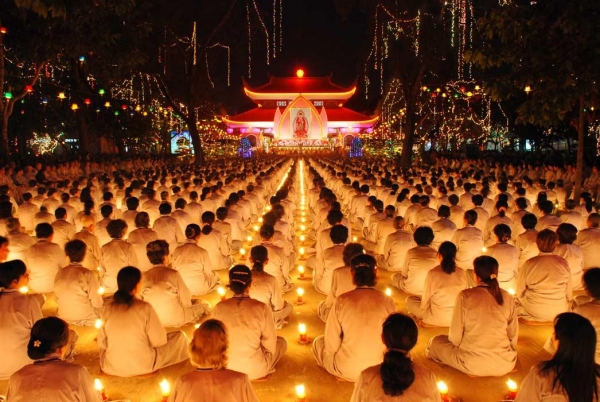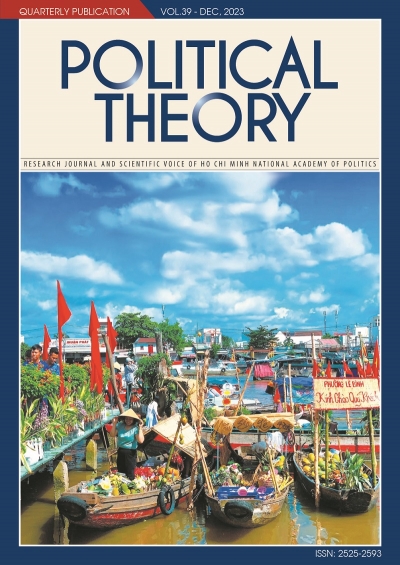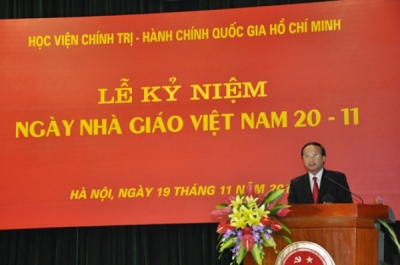Influences of religious change on Vietnam's traditional customs and practices
(LLCT) - Religious change in Vietnam has a major influence on traditional customs and practices in both positive and negative directions. On the one hand, it contributes to restoring many fine national traditions and customs and changing the lifestyle and behavior of a group of people. On the other hand, it revitalizes many customs and backward practices, distorting and fading some customs and traditions. These impacts have raised many issues to the Party and the State and need to be solved in the course of national construction and development in the new period.
Keyword: religious change in Vietnam; traditions and customs.
In recent decades, in the context of globalization, global religious life has been diversified and got complicated. The number of religions in the world is constantly increasing; major religions with long histories such as Catholicism, Islam, Protestantism, and Buddhism are trying to expand their sphere of influence out of their traditional areas and actively self-adapt, integrate and participate in social activities, greatly affecting the socio-political life of many countries. The above-mentioned transformation in the world has brought about new colors to global religious life, contributing positively to society. At the same time, the transformation creates many complicated implications for the life of mankind.
In this context, the religious policies of the Party and the State of Vietnam have made significant changes in the religious life in this country. Religious change in Vietnam takes place in all aspects, from religious beliefs to religious practices and religious communities. In general, most religions in Vietnam strive to expand the sphere of influence in society. Besides, there are many new religious phenomena throughout the country.
Changes in religious life in Vietnam in recent years have had a great influence on the customs and practices of the Vietnamese people in both positive and negative directions.
1. Positive effects
In the context of thriving religious activities, many of the customs and practices of humane values have been restored and practiced vividly in social life. Customs such as visiting Buddhist pagodas at the beginning of the year, fasting, and animal-releasing (tsethar) associated with Buddhism are typical examples.
Going to a pagoda at the beginning of the new lunar year is a fine tradition in Vietnamese culture that began in ancient times. After Lunar New Year’s Eve (Tet), people go to the pagodas to pray for a new year of peace, happiness, and prosperity for their families. In recent years, along with the development of the country, many spacious pagodas have been built in all provinces and cities. People also go to temples to worship on the full moon day and the first day of the month. During Tet holiday, there are even more people visiting temples and pagodas. After Lunar New Year’s Eve, pagodas, temples, and worship facilities receive many visitors. This bustling atmosphere lasts from the first day of the Lunar New Year to the end of the first lunar month.
Vegetarianism (vegan script is translated from the original Sanskrit word “Upavasatha”, meaning Pure), according to the concept of the majority of Mahayana Buddhists in Vietnam, brings people a pure mind and compassion for sentient beings. Nowadays, the number of Buddhist followers and vegetarian practitioners is increasing. To meet their needs, many pagodas often organize vegetarian meals to serve worshipers on the first and fifteen days of the lunar month. Besides, there are quite a lot of restaurants specializing in vegetarian food for the increasing vegetarian demand of the people. While not all vegetarians in Vietnam today are Buddhists, most of them are influenced by the Buddhist faith.
The custom of tsethar (originating from Chinese Buddhism) also has a profound meaning, conveying Buddha’s compassion and respect for the life of all beings. This custom has had a long-lasting influence in Vietnamese folklore and in recent years has been of some Buddhist monks’ concerns to be restored.
It can be said that going to pagodas at the beginning of the year, fasting and tsethar are beautiful customs maintained in Buddhist activities in Vietnam, which contribute to educating Vietnamese people about the need to do to the good.
Additionally, a number of other customs and practices are also greatly influenced by the change of Buddhism. The trend of young people going to pagodas to perform marriage rituals to increase sacredness is increasing in many provinces and cities across the country. Along with that, the funerals of the Kinh (the ethnic majority in Vietnam) also have the presence of a monk praying for the souls of the deceased. Besides, rituals like setting up offerings for 35 days or 49 days after the death of the deceased have also increased in many localities across the country. These activities, if organized well, will have the effect of satisfying spiritual needs and balancing the spiritual life for a part of the people. This is also a beauty that Buddhism brings to the traditional culture of the nation.
For Protestantism, the presence of this religion and its teachings, rules, and rituals have completely changed the way of life of the followers from ethnic minorities. Some believers who are from ethnic minorities have changed from being polytheistic to monotheistic, only believing in God. This worldview change has led to many changes in the lifestyle of the people. When practicing religion, ethnic minorities are liberated from the bonds of annoying, expensive rituals and outdated practices, gradually forming a new life in the community. In fact, in the Northern mountainous region and the Central Highlands region, in villages where there are a large number of Protestant ethnic minorities, the lifestyle of the people has developed progressive aspects such as hygienic living and housing areas, drinking water, clean roads to villages, diminished backward customs, and village boys who do not drink alcohol or smoke. When sick, they no longer believe in worshiping or exorcising spirits, but going to health facilities for medical examinations and treatment. They no longer leave the deceased in the house, which causes pollution, as they did before and weddings and funerals feasts do not last long, which saves money. There is no need to kill buffaloes and cow for rituals and feasts. Children’s education is also more of a concern.
According to Nguyen Quynh Tram’s survey in Lao Cai province in 2014, the traditional Mong custom of exacting wedding-presents (considered a challenge issued by a girl’s family) from the future bridegroom’s family, usually range from 40-50 million VND, but among the Protestant Mong people, it is only about 10 million VND; the cost for a Mong traditional wedding is about 70 million VND, while Protestant Mong people only have to pay about 20 million VND(1). Most of the Protestant Mong people in the Northwest region said that when they joined the religion, they learned how to maintain personal and family hygiene (73.5%) and 92.3% disagreed with the slaughtering of buffaloes and cows when there was a funeral. At the same time, there were very few religious people who wanted to organize funerals lasting from 3 to 5 days (3.1%), and 68.9% of the Protestant followers said that they paid more attention to their children’s education after they started practicing the religion(2).
Previously, the daily life and exchange of ethnic minorities only happened within their lineages, villages, and ethnic groups. Since joining Protestantism, the exchange relationship has been expanded to outside clans, villages, and other ethnic groups. Additionally, religious activities are also an environment for believers to acquire knowledge and enhance their understanding about breeding, cultivation, business, and trading and become more actively engaged in socio-economic development. It can be said that Protestantism has brought a segment of ethnic minorities to a new lifestyle with many positive impacts.
2. Negative impacts
Besides positive impacts, religious change in Vietnam has also had a significant negative impact on Vietnamese customs and practices, leaving consequences for the national culture. Along with the excitement of religious life, many backward customs and practices also have a strong chance of revival.
For Buddhism, the impact of the market economy and the secularization trend has gradually distorted and misled customs and traditions used in Buddhist activities.
The custom of going to the pagoda at the beginning of the year and the custom of tsethar are of profound humane meaning. However, now, these customs are being practiced in a misguided manner. Many people no longer care about the true meaning of these customs, but rather practice them according to the trends and by formality. In the festival season at the beginning of the year, many people and families go to the pagoda to pray for their mundane and earthly needs in boisterous crowds. People also perform the tsethar rite according to the trend without knowing its true meaning. In every Yulan season, many people come to the pagoda to release birds and fish which are captured and sold again. Therefore, after a number of tsethar rituals, birds and fish are not saved but killed in a series.
Besides, religious changes have formed religious markets with different types of spiritual services that can be clearly seen in the vibrant activities of Buddhism. The bustle of services such as votives, praying for safe, warding off the evils, preparing incense burners, and telling the good directions of the house and the kitchen have flourished in many localities, costing the society money. Buddhist activities in some places are being transformed with negative activities, which have a very bad impact on social life. The phenomenon of giving offerings to relieve one’s bad lucks in some pagodas in the North or the phenomenon of warding off the spirit coming back for retribution in Ba Vang pagoda recently caused many consequences for Buddhism and society.
Funeral rituals for some groups of people have also been recovered and are quite cumbersome and costly with many procedures like choosing the date, picking up the time, relieving bad lucks from the funeral, setting up a requiem, and worshiping with the assistance of Buddhist monks at a high cost. In Hai Phong city, for nearly ten years, a service of “leading the spirit” has been formed with a very sophisticated Buddhist participation; a funeral service organized by the pagoda comes up to 150 million VND(3).
In the new trend, the faith practice of Vietnamese Catholics also has certain changes as well as certain negative effects on the lives of the people. According to Christian doctrine, the Holy Mary and the saints do not have the right to bless but act as an intermediary between God and believers. However, for Vietnamese Catholics, the Holy Mary has long been proclaimed to be Blessed Mother with infinite devotion. In recent years, some Vietnamese Catholics have also tended to be excessively devoted to the Holy Mary in the direction of superstition.
The most negative impact of religious change on Vietnamese customs and traditions is the development and impact of Protestantism on traditional customs and practices of Vietnamese ethnic minorities. Many good values in their traditional customs have been affected, even removed completely. For example, for the Mong people, the practice of sacrificial ritual such ancestor worship, community god worship, and lineages is one of the traditional beliefs and the glue that unites all family members, lineages and the community. However, with the Protestant Mong people, due to differences in faith, the above rituals were abolished and completely replaced with religious rites. Recent survey results show that only 4.4% of the Hmong people who practice Protestantism in the Northwest region still perform ancestor worship rituals; up to 95.6% do not (4). Mong people also have many special traditional festivals such as a Thanksgiving Ceremony (expressing gratitude to ancestors and parents), Nao cong and Nao song Festivals (ceremony of convention to implement common rules of the community), and the Gau tao festival (homeowners pray for children, the community prays for bumper harvests, and the girls and boys pray for marriage). Mong festivals also contain quite a lot of unique cultural values; however, currently only 6.1% of Mong people who follow a religion still participate in the aforementioned festivals(5).
In the Central Highlands region, a situation similar to that of the Northwest region occurred. In the early period, when renouncing their traditional beliefs to follow Protestantism, the majority of ethnic minorities also completely broke off from their traditional culture, causing cultural breaks, fading the ethnic cultural identity, and gradually losing the Central Highlands identity(6).
In addition to the effects of the change of religions such as Buddhism, Catholicism and Protestantism, a number of religious phenomena that have appeared in recent decades also have a significant impact on customs and practices.
That more and more religious phenomena related to the worship of Hung Kings, the worship of President Ho Chi Minh and the cultural celebrities of the nation emerge, on the one hand, affirms and honors the cultural values of the people, while on the other hand, has an adverse impact on culture, customs and social ethics. In some localities, followers of the above-mentioned religious phenomena have removed their ancestral altars, causing conflicts and lost solidarity in families and lineages.
In particular, in the trend of new religious phenomena, the emergence of anti-cultural and inhumane religious phenomena has extremely negative impacts on culture, morality, and customs of the nation. The once phenomenon of Toc pha religious sect in Thuan Chau, Son La province or Chan khong of Luu Van Ty were typical examples. At present, new religious phenomena such as Ha mon, and Ami sa ri in the Central Highlands with many superstitious manifestations have also had negative effects on the social and cultural life of ethnic minorities. Or most recently, the development of the Church of God the Mother in many provinces and cities across the country has raised “alarm bells” about the negative effects of new religious phenomena on culture, customs, and religion and traditional national virtue in the new period. Recently, the activity of a group of people practicing a strange religious phenomenon that caused the death of two people in Binh Duong also shows that the new religious phenomenon not only has an adverse impact on traditional culture, customs and morals but also adversely affects security and social order.
The above-mentioned reality is posing many problems to our Party and State, which are how to promote the good and beautiful features of religions to serve the process of building an advanced culture and imbued Vietnamese national identity, while at the same time limiting religious negative effects on the development of the country in the new era.
______________________
Endnotes:
(1) Nguyen Quynh Tram: Culture of Hmong following Protestantism in Lao Cai province, Anthropological Thesis - Vietnam Academy of Social Sciences, 2016.
(2), (4), (5) Ho Chi Minh National Academy of Politics: Overview Report of Basic Investigation Project: Investigating and surveying socio-cultural changes in ethnic minority areas after joining Protestantism in the Northwest (Project Manager: Assoc. Prof., Dr. Le Van Loi), Hanoi, 2017.
(3) Funeral parlor service is started from the Ven pagoda (To Hieu Street, Le Chan District, Hai Phong City).
(6) Ho Chi Minh National Academy of Politics: Survey of the project: New issues in religions and beliefs in ethnic minorities in Vietnam today. Code: CTDT: 34.18 / 16-20, implemented in 2018-2019 in Dak Lak, Dak Nong and Kon Tum).
Assoc. Prof., Dr. Hoang Thi Lan
Ho Chi Minh National Academy of Politics
Journal Archives
Journal Archives
Media
Photo Gallery
Contact us






